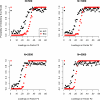Model selection and psychological theory: a discussion of the differences between the Akaike information criterion (AIC) and the Bayesian information criterion (BIC)
- PMID: 22309957
- PMCID: PMC3366160
- DOI: 10.1037/a0027127
Model selection and psychological theory: a discussion of the differences between the Akaike information criterion (AIC) and the Bayesian information criterion (BIC)
Abstract
This article reviews the Akaike information criterion (AIC) and the Bayesian information criterion (BIC) in model selection and the appraisal of psychological theory. The focus is on latent variable models, given their growing use in theory testing and construction. Theoretical statistical results in regression are discussed, and more important issues are illustrated with novel simulations involving latent variable models including factor analysis, latent profile analysis, and factor mixture models. Asymptotically, the BIC is consistent, in that it will select the true model if, among other assumptions, the true model is among the candidate models considered. The AIC is not consistent under these circumstances. When the true model is not in the candidate model set the AIC is efficient, in that it will asymptotically choose whichever model minimizes the mean squared error of prediction/estimation. The BIC is not efficient under these circumstances. Unlike the BIC, the AIC also has a minimax property, in that it can minimize the maximum possible risk in finite sample sizes. In sum, the AIC and BIC have quite different properties that require different assumptions, and applied researchers and methodologists alike will benefit from improved understanding of the asymptotic and finite-sample behavior of these criteria. The ultimate decision to use the AIC or BIC depends on many factors, including the loss function employed, the study's methodological design, the substantive research question, and the notion of a true model and its applicability to the study at hand.
(c) 2012 APA, all rights reserved
Figures




Similar articles
-
Asymptotics of AIC, BIC, and RMSEA for Model Selection in Structural Equation Modeling.Psychometrika. 2017 Jun;82(2):407-426. doi: 10.1007/s11336-017-9572-y. Epub 2017 Apr 26. Psychometrika. 2017. PMID: 28447310
-
Performance of Akaike Information Criterion and Bayesian Information Criterion in Selecting Partition Models and Mixture Models.Syst Biol. 2023 May 19;72(1):92-105. doi: 10.1093/sysbio/syac081. Syst Biol. 2023. PMID: 36575813 Free PMC article.
-
Assessing the practical differences between model selection methods in inferences about choice response time tasks.Psychon Bull Rev. 2019 Aug;26(4):1070-1098. doi: 10.3758/s13423-018-01563-9. Psychon Bull Rev. 2019. PMID: 30783896 Free PMC article.
-
Sensitivity and specificity of information criteria.Brief Bioinform. 2020 Mar 23;21(2):553-565. doi: 10.1093/bib/bbz016. Brief Bioinform. 2020. PMID: 30895308 Free PMC article. Review.
-
Using Latent Class Analysis to Model Preference Heterogeneity in Health: A Systematic Review.Pharmacoeconomics. 2018 Feb;36(2):175-187. doi: 10.1007/s40273-017-0575-4. Pharmacoeconomics. 2018. PMID: 28975582
Cited by
-
Magnitude and predictors of obstetric complications during delivery among postpartum women in Ethiopia: evidence from PMA Ethiopia longitudinal survey.BMC Pregnancy Childbirth. 2024 Oct 26;24(1):703. doi: 10.1186/s12884-024-06904-2. BMC Pregnancy Childbirth. 2024. PMID: 39462328 Free PMC article.
-
Systems Biology Will Direct Vascular-Targeted Therapy for Obesity.Front Physiol. 2020 Jul 15;11:831. doi: 10.3389/fphys.2020.00831. eCollection 2020. Front Physiol. 2020. PMID: 32760294 Free PMC article.
-
Cognitive model construction and assessment of data analysis ability based on CDA.Front Psychol. 2022 Nov 15;13:1009142. doi: 10.3389/fpsyg.2022.1009142. eCollection 2022. Front Psychol. 2022. PMID: 36457914 Free PMC article.
-
Healthcare preferences of the general Chinese population in the hierarchical medical system: A discrete choice experiment.Front Public Health. 2022 Nov 17;10:1044550. doi: 10.3389/fpubh.2022.1044550. eCollection 2022. Front Public Health. 2022. PMID: 36466449 Free PMC article.
-
Using neighborhood characteristics to predict vacancy types: Comparing multi-scale conditions surrounding existing vacant lots.Environ Plan B Urban Anal City Sci. 2023 Nov;50(9):2594-2609. doi: 10.1177/23998083231160542. Epub 2023 Mar 10. Environ Plan B Urban Anal City Sci. 2023. PMID: 37974590 Free PMC article.
References
-
- Akaike H. A new look at the statistical model identification. IEEE Transactions on Automatic Control. 1974;19:716–723.
-
- Anderson D, Burnham K. Avoiding pitfalls when using information-theoretic methods. Journal of Wildlife Management. 2002;66:912–918.
-
- Atkinson A. A note on the generalized information criterion for choice of a model. Biometrika. 1980;67:413–418.
-
- Atkinson A. Likelihood ratios, posterior odds, and information criteria. Journal of Econometrics. 1981;16:15–20.
-
- Barron A, Birgé L, Massart P. Risk bounds for model selection by penalization. Probability Theory and Related Fields. 1999;113:301–413.
Publication types
MeSH terms
Grants and funding
LinkOut - more resources
Full Text Sources
Other Literature Sources
Medical

